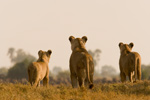It’s not widely known that the African lion ((Panthera leo) is currently threatened with extinction in the wild, but listed as Vulnerable by the IUCN Red List, the king of animals has declined by over 90% in the past 50 years (from 450,000 lions to between 20,000 and 40,000 today). While conservation work to save the species is on-going in Africa, efforts have now moved to the US as well, where a coalition of conservation groups are filing a petition with the US Department of the Interior to list lions as ‘endangered’ under the Endangered Species Act (ESA). Such a listing would make it illegal to bring lion parts in the country, including those killed by recreational trophy hunters.
“The king of the jungle is heading toward extinction, and yet Americans continue to kill lions for sport,” said Jeff Flocken, Washington-DC office director of the International Fund for Animal Welfare (IFAW), one of the petitioning organizations. “Our nation is responsible for importing over half of all lions brought home by trophy hunters each year. The African lion is in real trouble and it is time for this senseless killing and unsustainable practice to stop.”
While lions are largely threatened by habitat loss, prey depletion, and human-wildlife conflict including revenge poisoning for loss of livestock, conservationists say trophy hunting plays a negative role as well. From 1998 through 2008 around 4,000 lion trophies were imported into the US, and that number is on the rise. But even these statistics don’t paint the whole picture. Dereck and Beverly Joubert, conservationists and filmmakers of the The Last Lion, have estimated that when one male lion is killed, around 24 other lions face death, given that in-coming males will kill cubs and even females.
“The US government must recognize that African lions are in danger of extinction throughout a significant portion of their range, acknowledge our nation’s significant role in the lion’s fate and bring greater scrutiny to all factors contributing to the decline of lion populations,” said Bob Irvin, senior vice president for conservation programs at the Defenders of Wildlife, which was joined by IFAW, Humane Society of the United States, Humane Society International, Born Free US, and Born Free Foundation on the petition.
A final decision by the Interior Department will likely take over two years.

Lions in Kenya’s Maasai Mara. In 2009 the Kenyan Wildlife Service warned that the nation’s lion population could disappear in 10-20 years. Photo by: Rhett A. Butler.
Related articles
A lion’s story, an interview with the filmmakers of The Last Lions

(02/14/2011) The new theatrical film, The Last Lions does not open, as one would expect, with a shot of lions or even an African panorama. Instead the first shot is a view of our planet from space at night. Billions of artificial lights illuminate continent showing just how much humans over the past few thousand years have come to dominate our world. Then comes the lions, but not in person, just in this staggering, and little known, statistic: in the last 50 years we have gone from a population of 450,000 lions to 20,000 today, a 95% decline. While the dramatic story of the The Last Lions follows the perils and tragedies of lion motherhood in one of the world’s last untouched places—the Okavango Delta—this statistic hangs over the film, reminding us that the story we are witnessing is on the verge of extinction.
Lion populations plummet in Uganda’s parks
(08/19/2010) Lion populations across Uganda’s park system have declined 40 percent in less than a decade, according to the Wildlife Conservation Society (WCS).
Updated: East Africa’s lions falling to poison
(05/11/2010) Eight lions have been poisoned to death in a month in Kenya, according to conservation organization WildlifeDirect. Locals, frustrated by lions killing their livestock, have taken to poisoning the great cats using a common pesticide in Kenya called carbofuran, known commercially as Furadan.